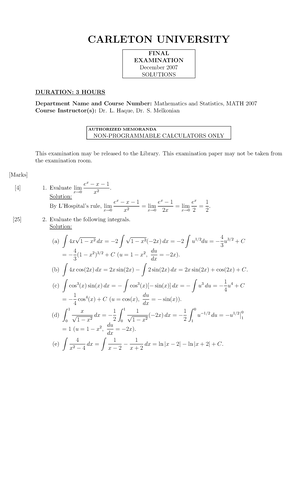- Information
- AI Chat
This is a Premium Document. Some documents on Studocu are Premium. Upgrade to Premium to unlock it.
Was this document helpful?
This is a Premium Document. Some documents on Studocu are Premium. Upgrade to Premium to unlock it.
Calculus Cheat Sheet
Course: Elementary Calculus II (Math 2007)
30 Documents
Students shared 30 documents in this course
University: Carleton University
Was this document helpful?
This is a preview
Do you want full access? Go Premium and unlock all 3 pages
Access to all documents
Get Unlimited Downloads
Improve your grades
Already Premium?

Limits & Derivatives Cheat Sheet
Properties of Limits
lim
𝑥→𝑎 𝑐𝑓 𝑥 = 𝑐 lim
𝑥→𝑎𝑓(𝑥)
lim
𝑥→𝑎[𝑓 𝑥 ±𝑔 𝑥 ]= lim
𝑥→𝑎𝑓(𝑥)± lim
𝑥→𝑎𝑔(𝑥)
lim
𝑥→𝑎[𝑓 𝑥 𝑔 𝑥 ]= lim
𝑥→𝑎𝑓(𝑥)lim
𝑥→𝑎𝑔(𝑥)
lim
𝑥→𝑎 𝑓 𝑥
𝑔𝑥=lim
𝑥→𝑎𝑓(𝑥)
lim
𝑥→𝑎𝑔(𝑥) 𝑖𝑓 lim
𝑥→𝑎𝑔(𝑥) ≠ 0
lim
𝑥→𝑎[𝑓 𝑥 ]𝑛= lim
𝑥→𝑎𝑓 𝑥 𝑛
Limit Evaluations At ±∞
lim
𝑥→+∞𝑒𝑥= ∞and lim
𝑥→−∞𝑒𝑥= 0
lim
𝑥→∞ln𝑥 = ∞and lim
𝑥→0+ln𝑥 = −∞
ifr > 0: lim
𝑥→∞ 𝑐
𝑥𝑟= 0
ifr > 0& ∀𝑥 > 0 𝑥𝑟∈ ℝ ∶ lim
𝑥→−∞ 𝑐
𝑥𝑟= 0
lim
𝑥→±∞𝑥𝑟= ∞forevenr
lim
𝑥→+∞𝑥𝑟= ∞and lim
𝑥→−∞𝑥𝑟= −∞foroddr
L’Hopital’s Rule
If lim
𝑥→𝑎 𝑓(𝑥)
𝑔(𝑥) =0
0or ±∞
±∞ then lim
𝑥→𝑎 𝑓(𝑥)
𝑔(𝑥) = lim
𝑥→𝑎𝑓′(𝑥)
𝑔′(𝑥)
Common Derivatives
𝑑
𝑑𝑥 𝑥 = 1 𝑑
𝑑𝑥[𝑎𝑓 𝑥 ] = 𝑎 𝑑
𝑑𝑥[𝑓 𝑥 ]
𝑑
𝑑𝑥 𝑎𝑥 = 𝑎 𝑑
𝑑𝑥 𝑎𝑥𝑛=𝑛𝑎𝑥𝑛−1
𝑑
𝑑𝑥 𝑐 = 0 𝑑
𝑑𝑥[𝑓 𝑥 ]𝑛=𝑛[𝑓 𝑥 ]𝑛−1𝑓′(𝑥)
𝑑
𝑑𝑥 1
𝑥𝑛= −𝑛𝑥−𝑛+1 = − 𝑛
𝑥𝑛+1
Derivative Definition
𝑑
𝑑𝑥 𝑓 𝑥 = 𝑓′𝑥 = lim
ℎ→0𝑓 𝑥+ℎ −𝑓(𝑥)
ℎ
Product Rule
𝑓 𝑥 𝑔 𝑥 ′= 𝑓′𝑥 𝑔 𝑥 +𝑓 𝑥 𝑔′(𝑥)
Quotient Rule
𝑑
𝑑𝑥 𝑓 𝑥
𝑔𝑥=𝑓′𝑥 𝑔 𝑥 −𝑓 𝑥 𝑔′(𝑥)
[𝑔 𝑥 ]2
Chain Rule
𝑑
𝑑𝑥 𝑓 𝑔 𝑥 = 𝑓′𝑔 𝑥 𝑔′(𝑥)
Derivatives of Trigonometric Functions
𝑑
𝑑𝑥 sin 𝑥 = cos𝑥 𝑑
𝑑𝑥 sec 𝑥 = sec𝑥tan𝑥
𝑑
𝑑𝑥 cos 𝑥 = −sin𝑥𝑑
𝑑𝑥 csc 𝑥 = −csc𝑥cot𝑥
𝑑
𝑑𝑥 tan 𝑥 = sec2𝑥𝑑
𝑑𝑥 cot 𝑥 = −csc2𝑥
Derivatives of Exponential & Logarithmic Functions
𝑑
𝑑𝑥 𝑒𝑥= 𝑒𝑥𝑑
𝑑𝑥 𝑎𝑥= 𝑎𝑥ln𝑎
𝑑
𝑑𝑥 ln|𝑥| = 1
𝑥𝑑
𝑑𝑥 ln𝑥 = 1
𝑥,𝑥 > 0
𝑑
𝑑𝑥 log𝑎𝑥 = 1
𝑥ln𝑎𝑑
𝑑𝑥 ln𝑓(𝑥) = 𝑓′(𝑥)
𝑓(𝑥)
𝑑
𝑑𝑥 𝑒𝑓(𝑥) =𝑓′(𝑥)𝑒𝑓(𝑥) 𝑑
𝑑𝑥 𝑎𝑓𝑥= 𝑎𝑓(𝑥) ln𝑎𝑓′(𝑥)
𝑑
𝑑𝑥 𝑓 𝑥 𝑔𝑥= 𝑓 𝑥𝑔𝑥𝑔 𝑥 𝑓′𝑥
𝑓𝑥+ln 𝑓 𝑥 𝑔′𝑥
@SmartGirlStudy | www.SmartGirlStudy.com
Derivatives of Inverse Trig Functions
𝑑
𝑑𝑥 sin−1𝑥 = 1
1−𝑥2𝑑
𝑑𝑥 sec−1 𝑥 = 1
|𝑥| 𝑥2−1
𝑑
𝑑𝑥 cos−1 𝑥 = − 1
1−𝑥2𝑑
𝑑𝑥 csc−1 𝑥 = − 1
|𝑥| 𝑥2−1
𝑑
𝑑𝑥 tan−1𝑥 = 1
1+𝑥2𝑑
𝑑𝑥 cot−1𝑥 =− 1
1+𝑥2
Basic Properties of Derivatives
𝑐𝑓 𝑥′= 𝑐[𝑓′𝑥 ]
𝑓 𝑥 ±𝑔 𝑥 ′=𝑓′(𝑥)±𝑔′(𝑥)
Derivatives of Hyperbolic Functions
𝑑
𝑑𝑥 sinh𝑥 = cosh𝑥𝑑
𝑑𝑥 sech𝑥 = −coth𝑥csch𝑥
𝑑
𝑑𝑥 cosh𝑥 = sinh𝑥 𝑑
𝑑𝑥 csch𝑥 = −tanh𝑥sech𝑥
𝑑
𝑑𝑥 tanh𝑥 = 1−tanh2𝑥
𝑑
𝑑𝑥 coth𝑥 = −1−coth2𝑥
Why is this page out of focus?
This is a Premium document. Become Premium to read the whole document.

